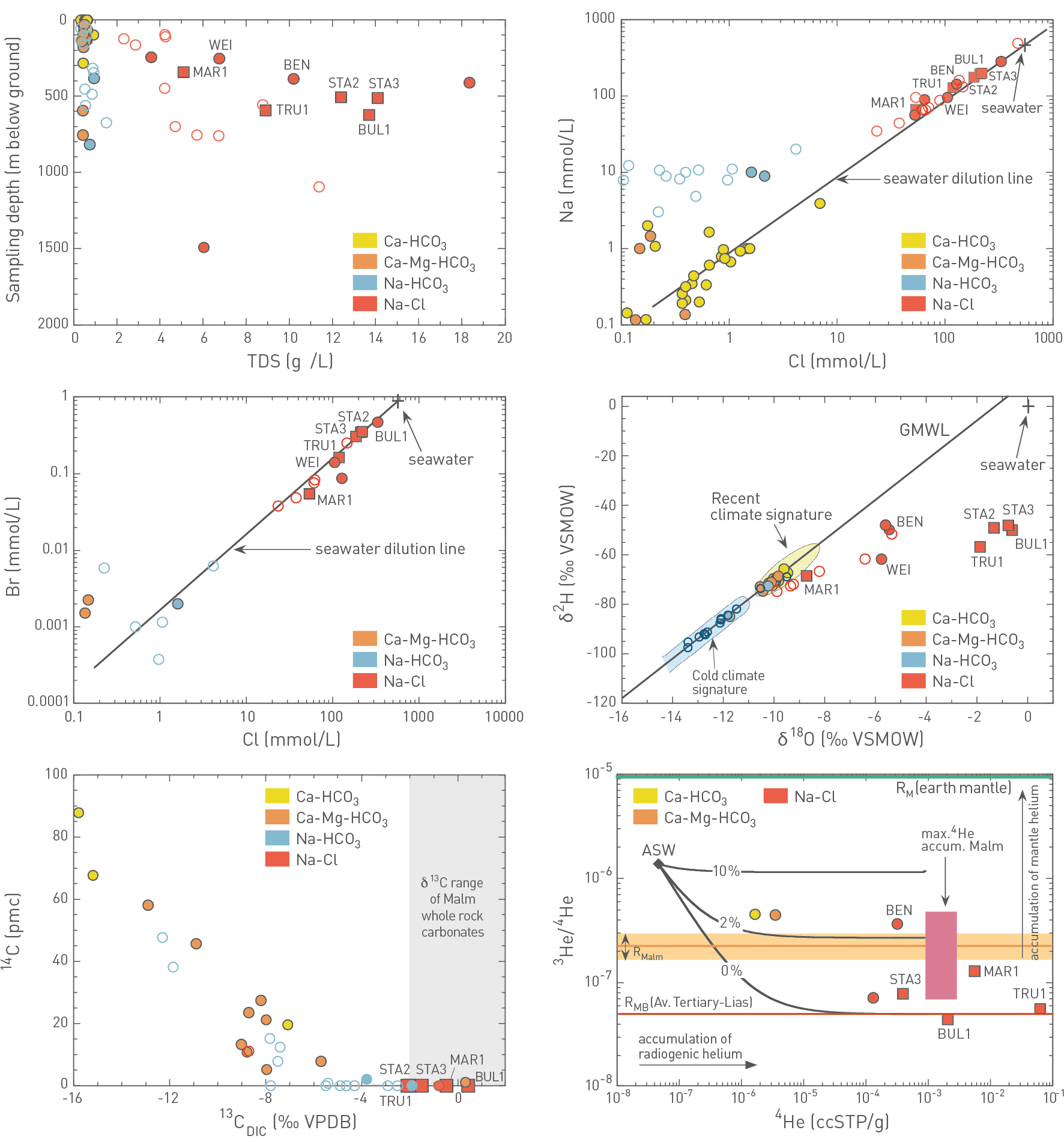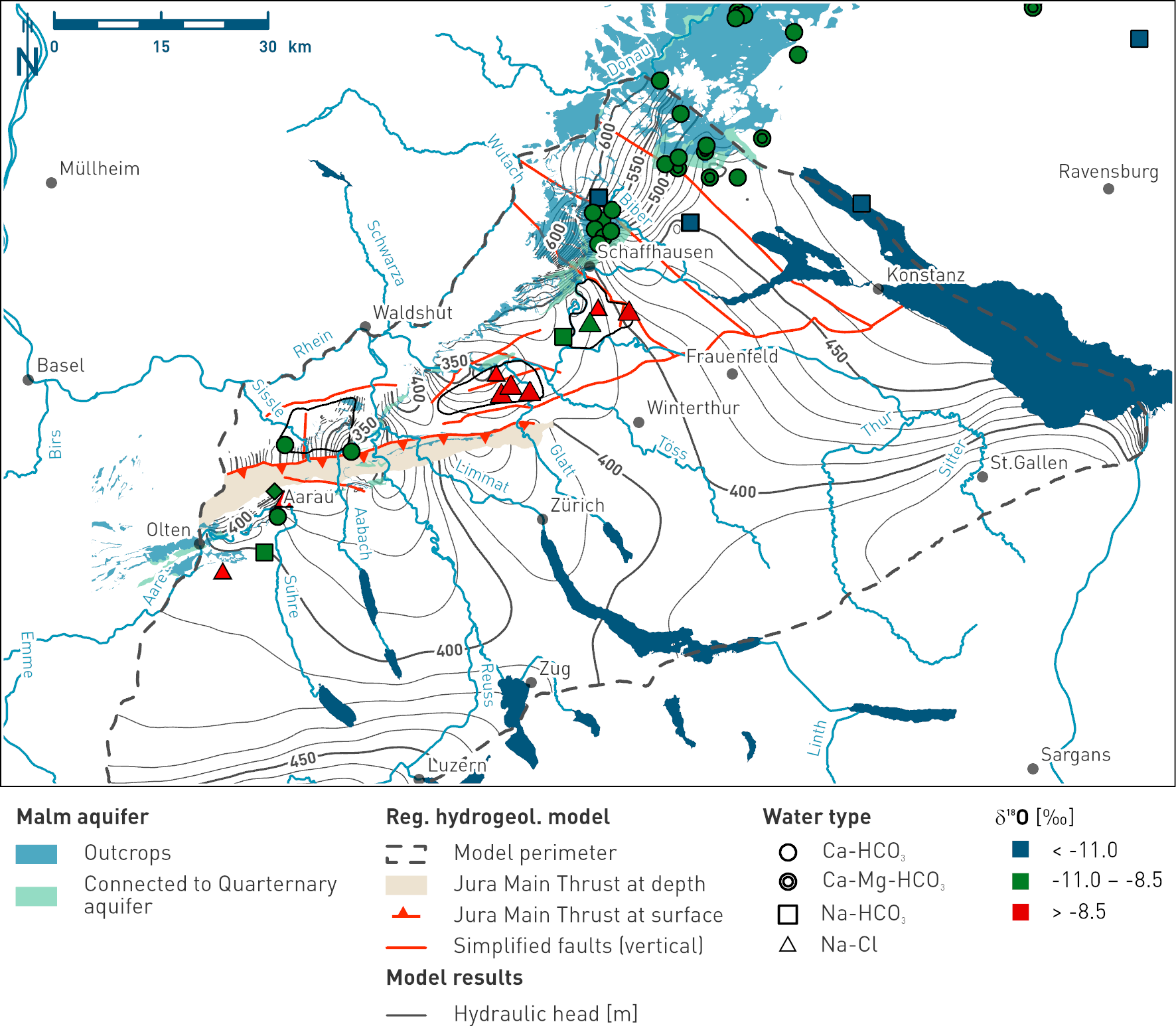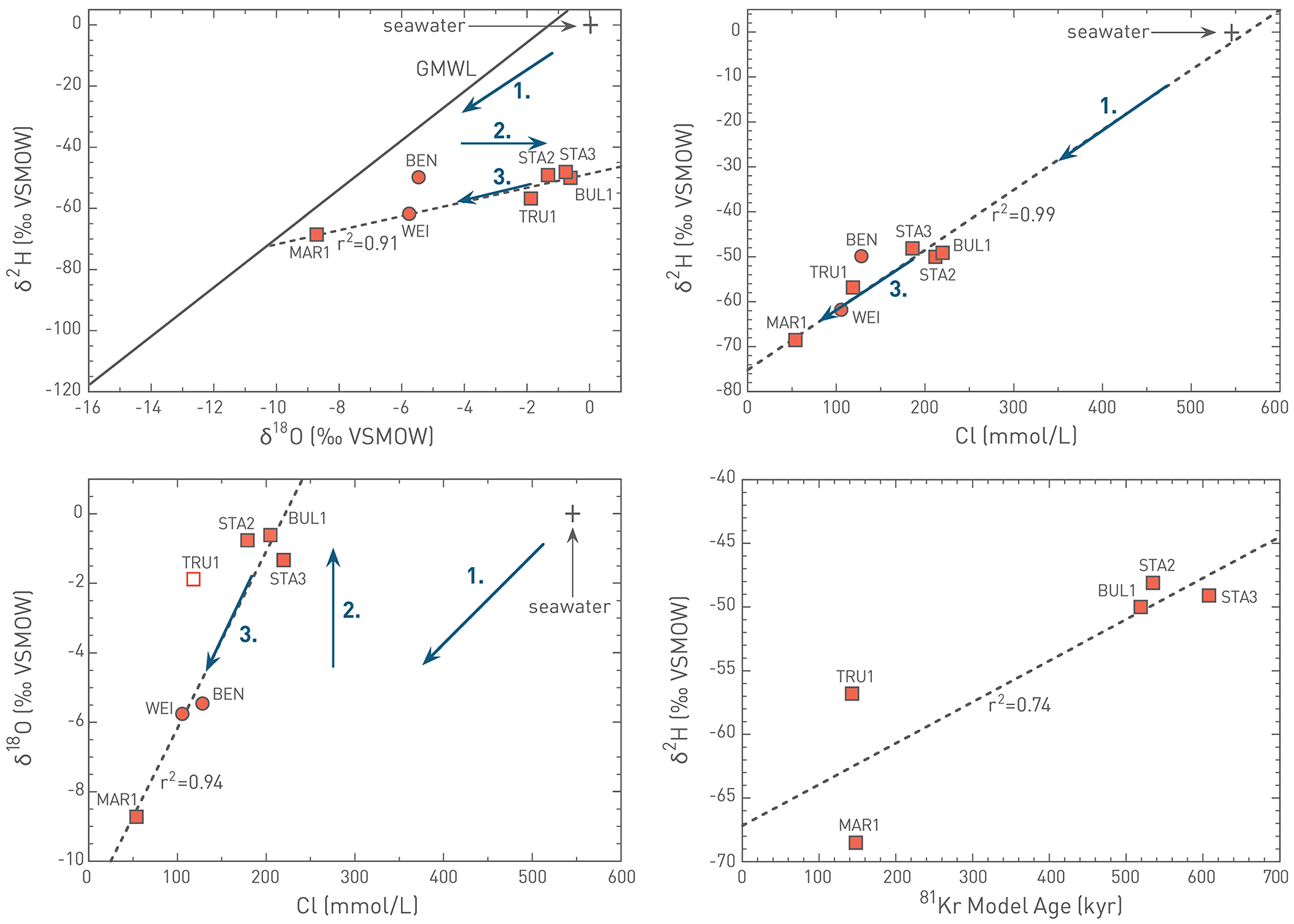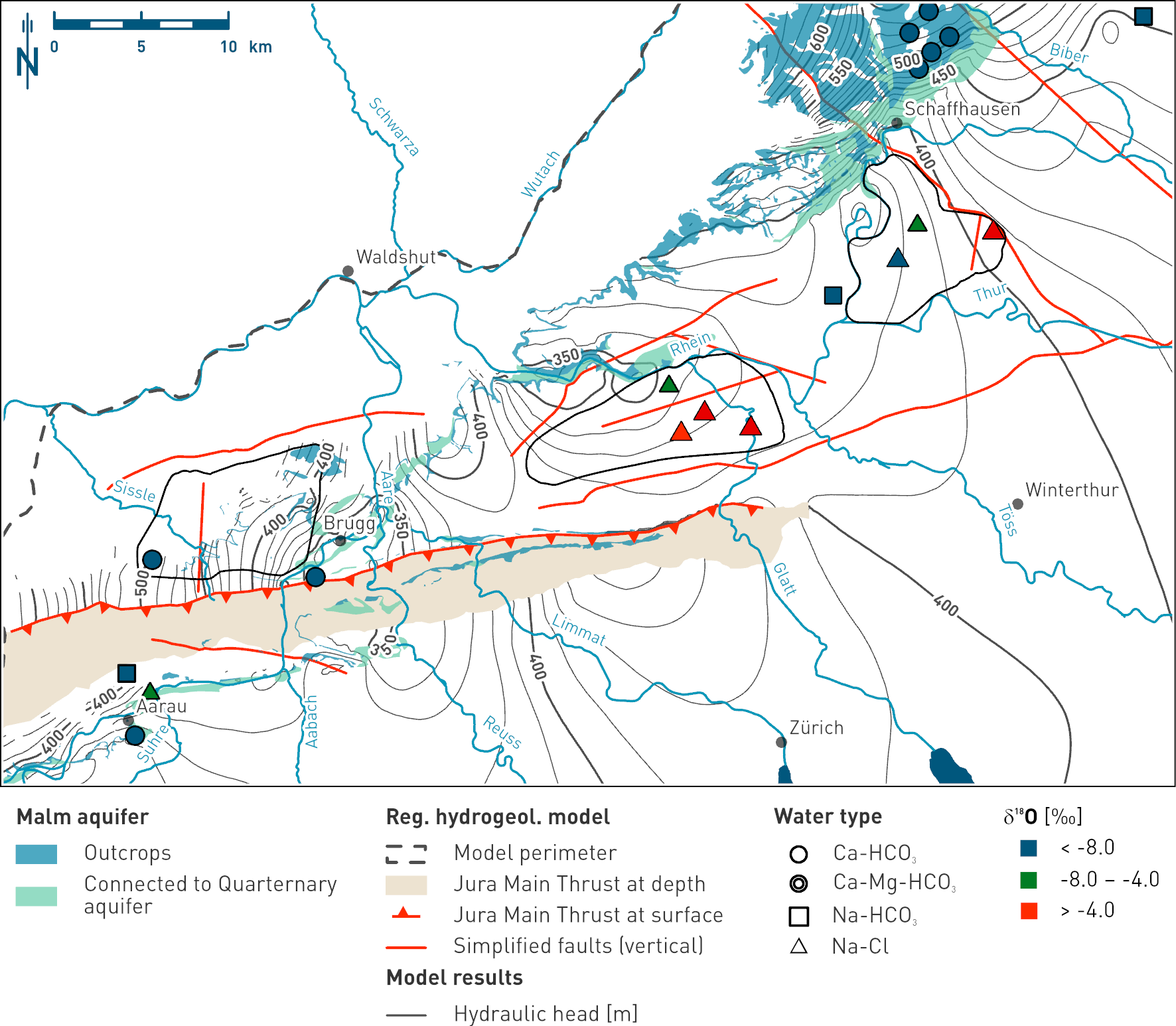A) Hydrogeochemical characterisation and groundwater origin
Groundwater samples from the Malm aquifer in Northern Switzerland and adjacent areas display a large range in composition and mineralisation (Fig. 4‑104). Low-salinity groundwaters with concentrations of total dissolved solids (TDS) below 2 g/L show a depth-dependent water composition. Samples taken from shallow boreholes ranging down to about 300 m below surface are of the Ca-HCO3 or Ca-Mg-HCO3 type. At greater depths, Na+ may become the dominant cation and groundwaters also relate to the Na-HCO3 type. In contrast, high salinity groundwaters with TDS concentrations of up to 19 g/L are of the Na-Cl type. In the Malm aquifer of Northern Switzerland, Na-Cl type groundwaters are almost exclusively observed in the ZNO and NL siting region. Moreover, they are closely related to Na-Cl type groundwaters from the Molasse aquifers located above (i.e. USM, OMM). Since Na-HCO3 type waters from the Malm and the Molasse aquifers also show strong similarities, both types of Molasse groundwaters are shown together with the Malm groundwater samples (Fig. 4‑104, open symbols).
The Na-Cl type groundwaters plot on or close to the seawater dilution line in the Br-Cl and Na‑Cl plots (Fig. 4‑104). Accordingly, they represent diluted seawater, which means that Cl and Na are of marine origin. In the stable water isotope plot, all Na-Cl type groundwaters are shifted to the right of the Global Meteoric Water Line (GMWL; Fig. 4‑104), which is consistent with a non-meteoric origin. In contrast, the low-salinity groundwaters (i.e. Ca-HCO3, Ca-Mg-HCO3, Na‑HCO3 type groundwaters) plot on the GMWL although actual values of stable water isotopes show quite large variations with δ18O ranging from -12 to -8 ‰. Values below -11 ‰, indicating meteoric water recharge during cold, glacial periods, are measured for the Na-HCO3 type groundwaters mainly occurring in the Bodensee region (Fig. 4‑105). In contrast, all Ca-HCO3 type groundwaters display δ18O values between -10 and -8 ‰ typical for recharge during climatic conditions similar to today.
The different water types are also reflected in groundwater residence times inferred from 3H and 14C activities. The Ca-HCO3 and Ca-Mg-HCO3 type groundwaters show significant 14C activities (Fig. 4‑104) and are often 3H-bearing, indicating that meteoric water recharge occurred in the recent past. In contrast, all Na-Cl type groundwaters and some of the Na-HCO3 type groundwaters are 14C-free, suggesting a residence time of more than ca. 40 kyr.
Na-Cl type groundwaters show elevated 4He concentrations up to 6 × 10-2 ccSTP/g (Fig. 4‑104). Based on the low 4He production rates of the Malm carbonates (Waber & Traber 2022), such 4He concentrations cannot result from in-situ 4He underground production over reasonable geological timescales. It follows that the 4He in the Na-Cl type groundwaters is of allochthonous origin. The most likely source is the diffusive 4He exchange between the Malm aquifer and the porewater of the adjacent aquitards. However, the observations that the 4He concentrations in the Malm aquifer at TRU1 and MAR1 are above those in the adjacent porewater (Rufer et al. 2024) demonstrate that other 4He sources are relevant as well (Ballentine & Burnard 2002). The most likely candidate is radiogenically produced 4He infiltrating into the Malm aquifer along deep-reaching faults.
B) Regional groundwater systems
The different hydrochemical signatures of the Malm groundwaters in Northern Switzerland reflect different stages in their hydrogeochemical evolution. This is discussed below for the three major water types.
Ca-HCO3 and Ca-Mg-HCO3 type waters: Shallow groundwaters close to outcrops
The chemical composition of the Ca-HCO3 and Ca-Mg-HCO3 type groundwaters is almost exclusively controlled by the chemical equilibrium between water, calcite (CaCO3), CO2 and, if present, dolomite (CaMg(CO3)2). Thus, they fully reflect the carbonate-dominated mineralogical composition of the Malm aquifer (Section 4.5.3.3). In Northern Switzerland, Ca-HCO3 type groundwaters occur at shallow depths (< 300 m) where the Malm units outcrop at the surface or where the Malm outcrops are in contact with unconsolidated rock aquifers such as at the southern margin of the Black Forest (Fig. 4‑105). Accordingly, they represent the first stage of the hydrogeochemical evolution when meteoric water infiltrates into the Malm aquifer. This is consistent with short residence times inferred from the detection of 3H, their high 14C activities and δ18O signatures overlapping with recent recharge signatures (Fig. 4‑104).
The Ca-Mg-HCO3 type waters are closely related to the Ca-HCO3 type. As a result of the comparatively slow reaction kinetics of dolomite (Lüttge et al. 2003), significant Mg concentrations are only observed if the residence time is sufficiently high to reach equilibrium with respect to dolomite. Accordingly, Ca-Mg-HCO3 type groundwaters reflect a slightly more evolved state than Ca-HCO3 type groundwaters, which is consistent with their lower 14C activity, less negative 13C values indicating more carbon isotopic exchange with Malm carbonates, and occurrence at greater depth (Fig. 4‑104).
Na-HCO3 type waters: Ca-exchanged groundwaters in the Bodensee region
In addition to the dissolution of carbonates and CO2, the chemical composition of Na-HCO3 type groundwaters is controlled by Ca-exchange reactions with Na-exchanged clays (Waber & Traber 2022), resulting in excess Na and the deviation of these groundwaters from the seawater dilution line in the Na – Cl plot (Fig. 4‑104). Based on the low abundance of clay minerals in the Malm aquifers, the chemical signature of Na-HCO3 type groundwaters is a clear indication for a hydraulic communication with the above-lying clay-mineral-rich Molasse units. This is well supported by the strong hydrogeochemical similarities between Na-HCO3 type groundwaters from the Malm and those from the Molasse aquifers (Fig. 4‑104). δ18O values below -11 ‰ indicate cold-time climatic recharge conditions (Fig. 4‑104). Together with their low or absent 14C activities (Fig. 4‑104), this suggests that in the Bodensee region vertical recharge of most Na‑HCO3 groundwaters occurred during the last glaciation between 12 and 115 kyr ago (Section 6.3; Schlüchter et al. 2021).

Fig. 4‑104:Cross-plots illustrating the behaviour of key hydrogeochemical parameters in groundwaters collected from the Malm (closed symbols) and Molasse aquifers (open symbols) in Northern Switzerland and Southern Germany
Filled circle and square symbols represent samples reported in Waber & Traber (2022) and collected during the TBO campaign, respectively. Open circle symbols refer to samples collected from Molasse aquifers to illustrate the similarity of Na-Cl and Na-HCO3 groundwaters collected from the Malm and Molasse aquifers. Sampling locations are only provided for the samples collected in the three siting regions.14C activities are corrected for drilling mud contamination and other sampling artefacts. RMB: average 3He/4He production ratio of Molasse to Lias Group sedimentary rocks in the Swiss Molasse Basin. RMalm: 3He/4He ratio (average and range) in Malm limestone of the BEN, OFT and SLA1 boreholes. Max. 4He accum. Malm: range of maximum accumulation of underground produced 4He in porewater under closed system conditions. ASW: air-saturated water (Kipfer et al. 2002). Black lines in the He-plot indicate the behaviour of hypothetical mixtures between ASW and RMB as well as different proportions of mantle helium (RM).

Fig. 4‑105:Map showing the spatial distribution of δ18O values in groundwaters collected from the Malm aquifer as an indication for the origin of the different water types
The symbols represent the water types while the colour of the fillings indicate the δ18O value range of the samples. The data range of δ18O of -11.0 to -8.5 ‰ VSMOW is representative for recent groundwaters of the region. Green colour denotes groundwater formed during climatic conditions similar as today in the study area. Groundwater samples marked in blue formed under colder climatic conditions. Groundwater samples marked in red (δ18O > -8.5 ‰ VSMOW) contain a significant amount of a modified seawater component (see text for details). The map also shows the Malm outcrops, the simplified regional fault pattern and the hydraulic heads according to the regional hydrogeological model (Section 4.5.4.2).
Na-Cl type waters: ZNO and NL siting regions
In contrast to the Ca-HCO3, Ca-Mg-HCO3, and Na-HCO3 type groundwaters, the chemical composition of the Na-Cl type groundwaters is dominated by an ancient seawater component overprinted by rock – water interaction processes. Hence, they represent the most evolved groundwaters of the Malm aquifer. In the ZNO and NL siting regions, all Malm groundwaters are of the Na-Cl type (Fig. 4‑104). Accordingly, understanding its hydrogeochemical evolution is of major interest. In general, the literature agrees that Na-Cl type groundwaters in the Malm aquifers originate from marine or brackish conditions prevailing during the sedimentation of the Upper Marine Molasse Group (OMM; Waber & Traber 2022 and references therein). Based on the hydrogeochemical similarity of Na-Cl and Na-HCO3 groundwaters from the Molasse (OMM, USM) and Malm aquifers (Fig. 4‑104), the OMM seawater penetrated downwards into the USM and eventually into the Malm aquifer. This is consistent with the hydrodynamic model indicating a vertical hydraulic gradient from the Molasse (USM) down to the Malm aquifer (Section 4.5.4.2).
In the plot of the stable isotopes of water (Fig. 4‑104), the Malm groundwaters from the ZNO and NL siting regions plot on a straight line to the right of the GMWL that is unable to match the composition of stable isotopes of current seawater. This suggests that they represent a mixture between an isotopically modified seawater and meteoric water. Based on the intersection of this correlation with the GMWL at a δ18O value of around -10.5 ‰, the meteoric water endmember probably infiltrated during an interglacial period similar to today. The proposed mixture is confirmed by excellent linear correlations between δ18O and Cl as well as δ2H and Cl (Fig. 4‑106). While the δ2H vs. Cl correlation falls on the seawater dilution line, the δ18O vs. Cl correlation is far off. This demonstrates that a process in addition to the dilution of seawater has modified δ18O values. The correlations between stable isotopes of water and Cl, as well as their relation to seawater, can be explained by a three-step hydrogeochemical evolution (Fig. 4‑106):
-
Dilution of seawater originating from OMM times with meteoric water during its downward migration into the Malm aquifer caused a shift of δ18O and δ2H values from seawater towards the GMWL. The amount of dilution and hence the resulting stable isotope values and Cl concentrations are unknown. The concentration of Cl, however, was higher than the maximum value measured in the two siting regions (ca. 200 mmol/L; Fig. 4‑104).
-
After emplacement of the groundwater in the Malm aquifer, the diluted and δ18O- and δ2H-modified seawater chemically and isotopically interacted with the Malm carbonates. Harrison et al. (2022) showed in laboratory experiments that the rate of oxygen isotope exchange between calcite and aqueous solutions is quite high, even under ambient conditions and chemical equilibrium, causing a measurable O isotope exchange over timescales of as little as weeks to months. Given that, after emplacement in the Malm aquifer, the groundwater interacted for at least several million years with the corresponding mineral phases, the groundwater δ18O values probably approached the O isotopic equilibrium with respect to calcite. Large temperature variations in the geological past (Mazurek et al. 2006), the unknown timing of the re-equilibration process, the strong temperature dependence of the oxygen isotope fractionation factor (Füger et al. 2018) and the variation of δ18O values of Malm carbonates (de Haller et al. 2011, Mazurek et al. 2018) means that the δ18O values after equilibration are not precisely constrained. Considering all uncertainties yields a re-equilibrated δ18O value in the range from 0 to 7 ‰. In contrast to δ18O, δ2H values are unaffected by the long-term interaction with calcite.
-
The infiltration of meteoric water during an interglacial period similar to today caused the dilution of the δ18O modified and diluted seawater. This eventually resulted in the observed correlations between δ2H and δ18O, δ2H and Cl, and δ18O and Cl (Fig. 4‑106).
The three-step model discussed above is fully consistent with the regional hydrogeological model proposed for the Malm aquifer (Section 4.5.4.2). For the northern parts of the ZNO and NL regions, the hydrogeological model implies that recharge occurs through the Malm outcrops north of the Rhine River (Fig. 4‑107). Accordingly, δ18O values are lower, the closer the sampling locations are to these outcrops. Based on the linear correlation between δ18O and Cl (Fig. 4‑106), the same applies for the Cl concentrations. It follows that the contribution of meteoric water in the groundwater mixture of the Malm aquifer increases with decreasing distance from the current recharge locations. Thus, the mixing ratio between the modified seawater and the meteoric water component is controlled by the current regional hydrogeological flow system.
Based on the lack of 14C in the in-situ groundwater samples from the ZNO and NL siting regions (Fig. 4‑104) and the signatures of stable water isotopes suggesting an interglacial composition similar to today, the meteoric component of the Malm groundwaters in the ZNO and NL siting regions has infiltrated in a previous interglacial period. This means that the corresponding residence time corresponds at least to the Eemian interglacial period 115 – 130 kyr ago (Preusser et al. 2011). This minimum results from the fact that the climatic signatures of cold climate recharge older than the last glaciation are likely to be masked by long-term mixing with multiple meteoric water components infiltrating under different climatic conditions, which could well be the case for the meteoric water component of the Malm groundwater in the ZNO and NL siting regions. Moreover, it should be noted that the minimum residence time estimate (115 – 130 kyr) also applies for the groundwater sample from MAR1, showing the highest contribution of the second, more recent meteoric water component of all Malm samples in the ZNO and NL siting regions.
The 81Kr model ages of groundwaters collected from the two siting regions range from 143 to 608 kyr and show a linear correlation with δ2H and hence with δ18O and Cl (Fig. 4‑106). Because the residence time of the modified seawater component from OMM times is of the order of several million years and the low solubility of Kr in seawater, the modified seawater component is probably 81Kr-free. Gerber et al. (2017) have shown that, for such mixing scenarios with an 81Kr-free endmember, 81Kr model ages are close to the model age of the younger 81Kr-bearing endmember. Accordingly, the residence time of the meteoric water component in the Malm aquifer of the ZNO and NL siting regions refers to the derived 81Kr model ages. In analogy to δ18O and Cl, the derived 81Kr model ages are consistent with the regional hydrogeological flow model (Section 4.5.4) A comparably low 81Kr model age of 148 kyr was obtained for MAR1, which is close to the Malm outcrops north of the Rhine River where recharge of meteoric water occurs (Fig. 4‑107). In contrast, the highest 81Kr model ages (> 519 – 608 kyr) are observed at STA2, STA3 and BUL1 where the hydraulic connection with the recharge location north of the Rhine River is poor, which fits well with a higher residence time of the diluting meteoric water component.

Fig. 4‑106:Correlations between values of stable isotopes of water and Cl concentrations as well as 81Kr model ages of Na-Cl type Malm groundwaters collected in the ZNO and NL siting regions
Circle and square symbols represent samples reported in Waber & Traber (2022) and collected during the TBO campaign, respectively. The linear correlations, plotted as dashed lines, were derived exclusively using the samples collected during the TBO campaign. The sample from TRU1 was not considered for calculating the linear correlation between δ18O and Cl because it probably experienced a slightly more complex hydrogeochemical evolution. The figure illustrates the evolution of the Na-Cl type groundwaters collected in the ZNO and NL siting regions. Numbers 1. – 3. refer to the steps in the hydrogeochemical evolution of these samples as described in the text.

Fig. 4‑107:Map showing the spatial distribution of the δ18O values of the Malm groundwaters as an indication for dilution of the modified seawater component with meteoric water
The symbols represent the water types while the colour of the fillings indicates the δ18O value range of the samples. Groundwater samples with a large proportion of the modified seawater component are marked in red. For Na-Cl type samples, green and blue denote samples increasingly diluted with a meteoric component. Note the different classes compared to Fig. 4‑105. The map also shows the Malm outcrops, a simplified regional fault pattern, and the hydraulic head isolines according to the regional hydrogeological model (Section 4.5.4.2).
Summary for the Malm aquifer in the siting regions
In conclusion, the Malm groundwaters in the ZNO and NL siting regions represent mixtures between i) diluted and isotopically modified seawater residing at least several million years in the aquifer and ii) meteoric water that infiltrated at least 115 kyr ago probably through the Malm outcrops along the Rhine River. Based on the very high groundwater residence times observed in the siting regions, flow rates are very low, and groundwater behaves almost like a stagnant water body. This is in agreement with the small geochemical gradients between pore- and groundwater observed notably in the NL siting region (Section 4.6). In other regions where the hydraulic conductivity of the Malm aquifer is much higher because of, for example, karstification, hydrochemically less evolved groundwaters (Ca-Mg-HCO3) are observed at the same depth as the Na‑Cl water samples in ZNO and NL (Fig. 4‑107). This comparison emphasises the strong control of the hydraulic conductivity on groundwater residence time and composition.

